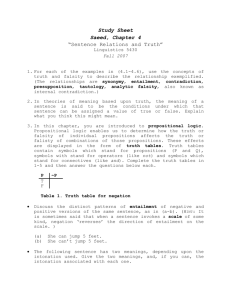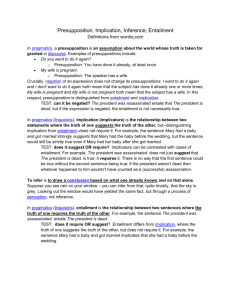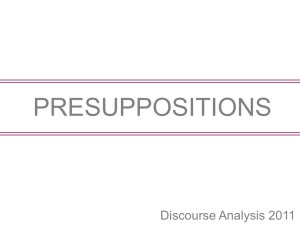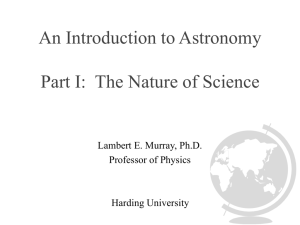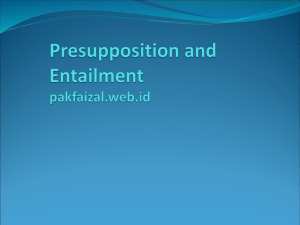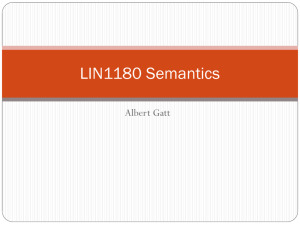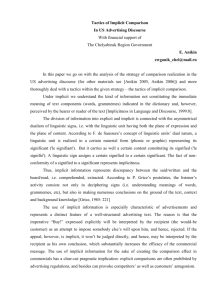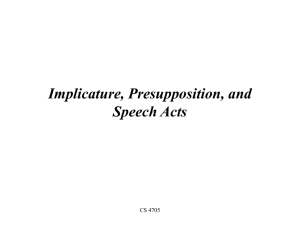Chapter 7 Information Structure and Presupposition Kjell Johan Sæbø Universitetet i Oslo
advertisement
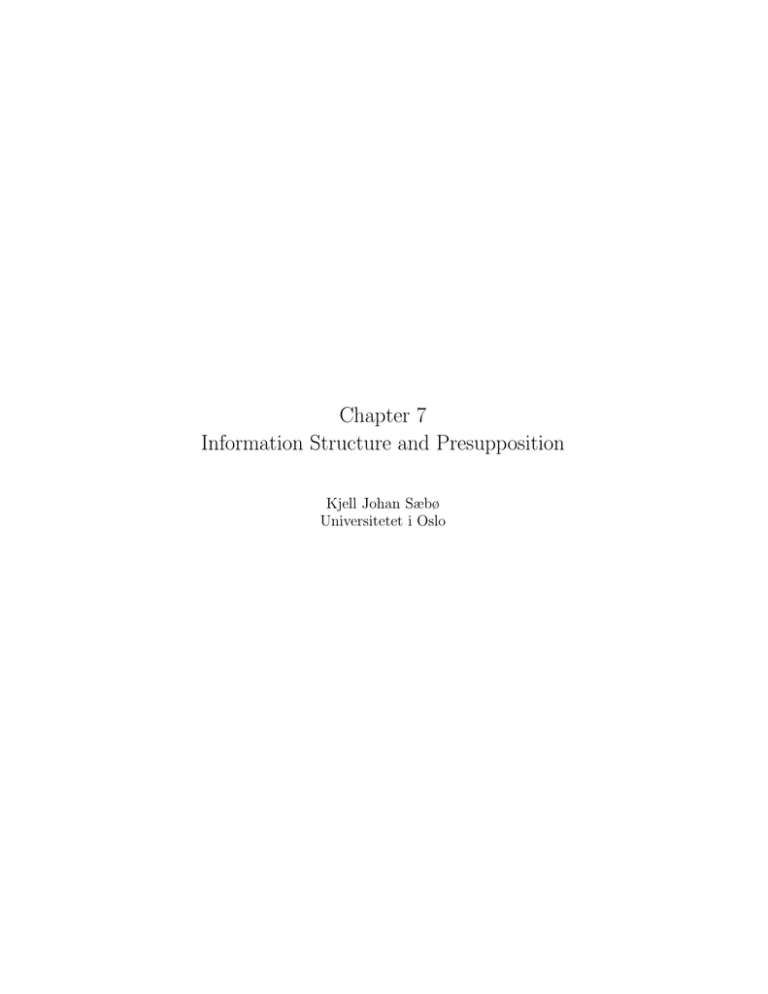
Chapter 7
Information Structure and Presupposition
Kjell Johan Sæbø
Universitetet i Oslo
Abstract
This article surveys and discusses the core points of contact between notions
of information structure and notions of presupposition. Section 1 is devoted
to the ‘weak’ presuppositional semantics for focus developed by Mats Rooth,
describing its properties with regard to verification and accommodation and
showing that it can successfully account for a wide range of phenomena. Section 2 examines the stronger thesis that focus-background structures give
rise to existential presuppositions, and finds the counterarguments that have
been raised to carry considerable weight. Section 3 looks into the relationship between Givenness and run-of-the-mill presuppositions, finding that
this relationship is looser than might be expected, mainly because a presupposition may be in need of focus marking instead of givenness marking.
Keywords
Presupposition · Focus · Background · Givenness
7.1
Introduction
Presupposition is, like information structure itself, a many-faceted notion.
Therefore, before addressing the areas where the two notions interconnect, it
is useful to briefly survey some ways in which presupposition is conceived.1
Presupposition is (Beaver and Geurts 2011)
the phenomenon whereby speakers mark linguistically the information
that is presupposed or taken for granted, rather than being part of the
main propositional content of a speech act.
This linguistic marking is done with presupposition triggers, forming a large
and varied class; the ones of special concern in the present article are, first,
prosodic focus marking (sections 7.2 and 7.3), second, additive markers like
too (sections 7.2, 7.3, and 7.4), and third, clefts and factives (section 7.4).
Classically, presuppositions have been considered as conditions that the
point of evaluation must meet for the sentences that carry them to be true
or false. For the phenomena at issue in this article, however, they are more
appropriately, in accordance with the dominant picture today, regarded as
conditions that the context, or the Common Ground, must meet in order to
be updated with the sentence. More specifically, the view where the context
is not only to entail the presupposition but also to provide antecedents for
referents in it, as most clearly expressed in Discourse Representation Theory
(‘presupposition as anaphora’, van der Sandt 1992), is particularly relevant.
In a looser sense of the term (‘pragmatic presuppositions’, Stalnaker 1974),
a presupposition associated with a sentence is something a speaker of the
sentence will usually presuppose, i.e., assume to be in the Common Ground;
this notion has some relevance for the issues discussed in section 7.3.
Three main areas can be identified where notions of presupposition and
notions of information structure interlock:
1. Arguably the most influential theory of focus interpretation, Rooth’s
Alternative semantics, is a theory which ascribes a presupposition to
a focus operator.
2. The background has traditionally been viewed as a presupposition, and
this view has had a recent revival.
3. As both information structure and lexically or syntactically triggered
presuppositions are sensitive to discourse structure, certain correlations can be expected to exist between these two types of phenomena.
1
See, e.g., Beaver and Geurts (2012) for a much more thorough description of the field.
1
These three areas are interwoven; in particular, there is a tension between
the focus presupposition in the sense of 1 and the background presupposition
in the sense of 2. A section will be devoted to each area: 7.2, 7.3, and 7.4.
7.2
The presupposition in Alternative semantics
The most successful understanding of focus, according to Krifka (2008: 247),
is captured by the central claim of Alternative semantics (Rooth 1992): focus
indicates the presence of alternatives that are relevant for the interpretation.
In the theory, this takes the form that focus introduces a presupposition
about the presence of alternatives. – The presuppositionality of focus under
this theory is rarely focused on; this section surveys the distinctive features
of the focus presupposition and its ability to account for various phenomena,
such as question-answer congruence, anaphoricity, and bridging inferences.
7.2.1
Focus semantic values and the ∼ operator
Alternative semantics has two central components (cf. Rooth 1992: 95):
1. a two-dimensional semantics defining focus semantic values with
reference to the focus feature F and ordinary semantic values,
2. the semantics of the covert focus interpretation operator ∼ ,
introduced in Logical Form.
Semantic composition proceeds at two levels: ordinary level and focus level.
The ordinary semantic value of an expression α is conventionally notated
as [[ α ]]o , while its focus semantic value is conventionally notated as [[ α ]]f .
Informally, the focus semantic value comes from the ordinary semantic value
by forming the set of semantic values where some alternative is substituted
for the value of the focused phrase.2 For example, if the ordinary semantic
value of (1a) is (1b), its focus semantic value is (1c), a set of propositions.
(1)
a.
b.
c.
she1 takes it2 with [ milk ]F
λw take w (g(2),milk , g(1))
λp ∃ Q p = λw take w (g(2), Q, g(1))
(= [[(1a)]]o g )
(= [[(1a)]]f g )
1 and 2 are referential indices and g is the contextual variable assignment.
Assume that the indexed focus interpretation operator ∼ adjoins to (1a):
(1)
2
d.
[ she1 takes it2 with [ milk ]F ] ∼3
For a more detailed description, see Rooth (this volume).
2
It is possible to give a direct definition of the meaning of ∼ if the meaning
of an expression α, [[ α ]] simpliciter, is conceived as the pair < [[ α ]]o , [[ α ]]f >.
(2)
[[ ∼ i ]]g = λφ : g(i) ∈ π2 (φ) . < π1 (φ), {π1 (φ)} >
This means: the meaning of the ∼ operator, indexed by the variable i, at g
takes a complex semantic value φ, consisting of an ordinary semantic value
and a focus semantic value, and returns that complex semantic value where
the latter is replaced by the singleton set containing the former, – provided
that the value assigned to i by g is a member of the focus semantic value.
This proviso is a presupposition, here modelled as a definedness condition,
in the notation of Heim and Kratzer (1998): λφ : presupp . content.3
The meaning of (1d) results from applying the definiens of (2) for i = 3
to the pair consisting of (1b) and (1c) and abstracting over g, yielding a
partial function from variable assignments to complex semantic values:
(3)
[[ [ she1 takes it2 with [ milk ]F ] ∼3 ]] =
λg [[ ∼ 3 ]]g (< [[(1a)]]o g , [[(1a)]]f g >) =
λg : g(3) ∈ λp ∃ Q p = λw take w (g(2), Q, g(1)) .
< λw take w (g(2),milk , g(1)), {λw take w (g(2),milk , g(1))} >
The presupposition in (2) is in fact often represented in two versions, as a
disjunction: g(i) is a member ∈ or a subset ⊆ of the focus semantic value.
This disjunction reflects an ambivalence in the theory; on the one hand,
sometimes the contextually determined value of the free variable i appears
to be a set of propositions, on the other hand, sometimes it appears to be
simply a proposition. Thus in the context sketched in (4), a case of questionanswer congruence, the value that can be assumed to be determined for i
is a set of propositions: { that Mary takes her tea with milk, that she takes
it with sugar, that she takes it with milk and sugar, that she takes it with
nothing at all }, while in the context sketched in (5), it would rather seem
that g(i) is a proposition: that Mary takes her coffee with nothing in it.
(4)
( – Does Mary take her tea with milk or sugar or both, or nothing?)
– She1 takes it2 with [ milk ]F .
(5)
(At home, Mary takes her coffee with nothing in it, but whenever she
has coffee here in France,) she1 takes it2 with [ milk ]F .
3
[[α]]o can in principle be of any (intensional) type; ∼ will mostly adjoin to a sentence,
but it may also adjoin at a lower level, applying, e.g., to a φ where π1 (φ) is a property.
3
Alongside its core function of accounting for focus as an information
structural phenomenon, Alternative semantics has been taken to provide a
key to predicting the partition of a sentence into restrictor and scope of
a quantificational adverb or the like. It has been assumed that (the union
over) (some subset of) the focus semantic value restricts the domain of quantification by being accommodated into the restrictor. This application of the
theory has met with criticism (see Cohen 2009 and references there). But the
‘quantificational’ role of focus is not an integral part of the theory; indeed,
Rooth (1992: 108f.) takes care to point out that ‘focus effects’ must be seen
as optional. Alternative semantics is primarily a theory of the informational
role of focus, and it is primarily as such that it is a presuppositional theory.
7.2.2
Anaphoricity
(2) is a formulation of the meaning of focus in a static semantic framework.
However, it is more adequate, and more in the spirit of Rooth (1992: 91f.),
to give a formulation in a dynamic framework, e.g., that of Roberts (2003),
where meanings are functions from contexts to contexts, conceived as pairs
of sets of discourse referents and sets of pairs of worlds and assignments.
This can better reflect the typically anaphoric nature of the presupposition:
the subset or element of the focus semantic value is a discourse antecedent.
(This also makes it possible to dispense with the index on the tilde operator.)
(6)
[[ ∼ ]] = λφ
< λC : (∃ i ∈ DomC )(∀hw, gi ∈ SatC ) g(i) ∈ π2 (φ) . π1 (φ)(C),
{π1 (φ)} >
In words: the meaning of the focus interpretation operator maps a meaning
φ containing an ordinary semantic value π1 (φ), now a function from contexts
to contexts, and a focus semantic value π2 (φ), now a set of such functions,
onto the meaning where the first member is the operation on contexts which
is only defined if there is a discourse referent i in DomC that all assignments
g ‘in’ SatC (the set of pairs of worlds and assignments that satisfy C) map
to a member of π2 (φ) and which if defined returns what π1 (φ) maps C to,
and where the second member is the singleton containing π1 (φ).4
4
Note that – when, as usual, the ∼ operator applies at a sentence level – g(i) is strictly
speaking no longer a proposition (or a set of propositions) but an operation on contexts (or
a set of operations on contexts), since the focus semantic value is now a set of operations
on contexts. For practical reasons, however, it will still be viewed and referred to as a (set
of) proposition(s).
4
The focus presupposition is now an anaphoric presupposition, parallel
to the presuppositions of, e.g., definite descriptions as described by van der
Sandt (1992) and in later work in this tradition. There must be an accessible
discourse referent which ‘is’ a member (or a subset) of the focus semantic
value (under any assignment in the context). For a definite, by comparison,
there must be an accessible discourse referent which ‘is’ a member of the
meaning of the NP under any assignment and at any world in the context.
This feature of the Roothian theory of focus as a presupposition trigger
is important because it predicts that focus is typically (or paradigmatically)
sensitive to discourse structure in the concrete sense of previous utterances,
such as the utterances of the bracketed material in (4) and (5). It has other
welcome consequences, too, which will be discussed below.
Two properties set the presupposition introduced by focus apart from
other anaphoric presuppositions, e.g., that introduced by a definite article.
First, a proposition (set) type discourse referent is assignment-independent,
and thus so is the presupposition: any such referent k in DomC ‘is’ a member (or a subset) of π2 (φ) under all g (and for all w) in SatC or under none.
This constancy is spelt out in SDRT (Segmented Discourse Representation
Theory, Asher 1993 and later work in this tradition), where proposition type
discourse referents are equated with representations of clauses as substructures in a multi-layered, or segmented Discourse Representation Structure.
Second, accessibility is not a real issue at this level. As shown by Asher
(1993: 225ff.), for general reasons of anaphora resolution, it must generally
be possible to declare a global-level discourse referent for a proposition, no
matter how deeply embedded it is; proposition-type discourse referents will
thus always be accessible. The same goes for other abstract entities such as
sets of propositions and properties.5 In (7a), the antecedent for the pronoun
it in the second clause is arguably the proposition that you are a lawyer,
and to enable this resolution, there must be a discourse referent for that
proposition accessible. In (7b), this same discourse referent can serve as a
target for the focus presupposition: the proposition that is its constant value
is a member of the focus semantic value.
(7)
a.
I noticed you are interested in becoming a lawyer.
It would make your mother proud of you.
b.
I noticed you are interested in becoming a lawyer.
[ My best friend ]F is a lawyer.
5
In the same vein, Rooth (1992: 88) takes note: ‘The semantic value of any phrase β
is a discourse object, available as an antecedent for free variables.’
5
Note, however, that this proposition is three times embedded, in particular,
under the non-veridical predicate interested . It is not, therefore, entailed
by the context. As in Dryer’s (1996) theory of ‘activated propositions’, it
suffices that some certain proposition (set) is present in the context.
Not anything goes, though. We have seen some examples of how the
focus presupposition can be verified; here is a case where it fails:
(7)
c.
I noticed you are interested in becoming a lawyer.
??I am a [ lawyer ]F .
Some would say, with Kratzer (2004) (who raises the issue in connection with
the stronger focus presupposition hypothesis discussed in section 7.3, but the
point applies here as well), that this infelicity is not typical of presupposition
failure, it is too mild and it certainly does not entail a truth value gap. But
it is not untypical of the incoherence effects one gets when presuppositons
like those triggered by even or too fail; cf. Glanzberg (2005), who argues
that not ‘all presupposition failures are expression failures’.
The dynamic formulation (6) is weaker than the static formulation (2)
in one key respect: what corresponds to the contextually determined value
for the free variable in (2) is some previously introduced discourse referent.
There are indications that the target for the focus presupposition must be
salient and recent, in fact, even more than usual for an anaphoric presupposition. In the examples given so far, the antecedent was indeed quite local.
One such indication will be considered more closely below (7.2.4).
7.2.3
Accommodation Effects
A hallmark of anaphoric presuppositions are so-called bridging inferences,
or accommodation effects, observed and discussed by, inter alia, Clark 1975,
Kripke 1991, and Kamp 1991 in connection with presupposition triggers like
the, again, and too. If a presupposition is not quite verified in the context,
we tend to build on what is there and accommodate the rest, often yielding
a stronger inference than if the presupposition were accommodated in toto.
That this pattern extends to focus presuppositions under Rooth’s theory
serves to strengthen the case for that theory.
Thus both (8a) and (8b) license the (false) inference that Kressmann is a
German winery; while in the first case, this is due to the presupposition of the
additive too, in the second case it is solely due to the focus presupposition.
(8)
a.
Mary brought a bottle of Kressmann Monopole. As it happened,
Sue, too, brought a bottle of German white wine.
6
b.
It was lucky that Mary brought a bottle of Kressmann Monopole.
[ Most ]F German white wines are [ sweet ]F .
For a constituent of the first clause to not just partially but fully meet
the condition of expressing a member of the focus semantic value of the
second clause, Kressmann Monopole must classify as an alternative to the
determiner most as applying to German white wines; hence the inference.
Note that the inference does not arise for reasons of discourse coherence: the
minimally different case (8c), focusing the modifier instead of the determiner,
licenses the (true) inference that Kressmann is not a German winery.6
(8)
c.
It was lucky that Mary brought a bottle of Kressmann Monopole.
Most [ German ]F white wines are [ sweet ]F .
Lakoff’s (1971) famous example (9a-b) fits smoothly into this picture.
(9)
a.
Paul called Jim a Republican. Then he1 [ insulted ]F him2 .
b.
Paul called Jim a Republican. Then [ he1 ]F insulted [ him2 ]F .
(9a) only requires us to accommodate that calling somebody a Republican
is a (distinct) alternative to insulting that person.7 (9b), on the other hand,
requires us to accommodate – and thus licenses the inference – that calling
someone a Republican is (a way of) insulting that person, as this is the only
way that the first sentence can count as expressing a member of the focus
semantic value of the second; that he1 is now Jim and him2 is now Paul is
also necessary for the first clause to count as expressing a proposition of the
form that some alternative to he1 insulted some alternative to him2 .
7.2.4
Locality of the Antecedent
Kamp and Bierwisch (2008) note an asymmetry between the presupposition
introduced by focus and the one introduced by the adverb again regarding
their domain of justification, understood as that portion of context that can
or must display their targets. This asymmetry comes to light in a contrast
like that between (10), specifically (10b), and (11).
(10)
(The first night, she cried for almost 30 minutes, . . . .
[ . . . ] The next night, she slept through till about 5.30am!)
6
These examples display two foci where the first can be called, and could alternatively
be treated as, a contrastive topic (see Büring, this volume).
7
The presupposed member of the focus semantic value [[ · ]]f is required to be distinct
from the ordinary semantic value [[ · ]]o (Rooth 1992: 90; cf. also Zeevat 2004).
7
a.
The [ next ]F night, she slept through [ again ]F ,
waking up just after 6am.
b. #The [ next ]F night, she [ slept through ]F again,
waking up just after 6am.
(11)
(Frankie was sleeping through but the other night he woke at 2am
– I tried everything else but he was hungry and wolfed down 8 oz.)
√
The [ next ]F night he [ slept through ]F again.
In (10a), both the focus presupposition and the presupposition of again are
verified in the very last sentence, and the discourse is felicitous. But (10b),
where the latter is again verified in the very last sentence but the former is
only verified in the less immediate context, is infelicitous. This situation is
reversed in (11), and this time, the discourse is again felicitous. Evidently,
then, the focus presupposition is more in need of being justified locally, in
the immediate context, than is a presupposition like that of again, though
both are arguably anaphoric in nature.
Why this should be so is not evident. But an explanation may be at hand
if the notion of an antipresupposition (Percus 2006) is taken into account.8
The basic idea is that any sentence with a presupposition competes with the
corresponding sentence without that presupposition, which, if used instead,
will impose the condition that the presupposition is not verified.
By this token, as far as focus presuppositions are concerned, (10b) will
‘antipresuppose’ what (10a) presupposes: that there is a proposition that
some other night she slept through. So, while (10b) has its focus presupposition verified in the less immediate context, it has a focus antipresupposition,
which should not be verified at all, verified in the immediate context. (11)
has it the other way around: the presupposition is verified in the immediate
context while an antipresupposition is verified in the less immediate context
– which is evidently much to be preferred.
If now it can be assumed that the immediate context has a prima facie
priority over the less immediate context, then verifying the presupposition
in the former gives a double gain: not just that the presupposition is verified
in the prime piece of context but also that no antipresupposition is verified
there. This might explain why focus presuppositions are so narrowly focused
on the immediate context.
What sets focus as a presupposition trigger apart from triggers like again
in this regard is that for any focus structure, there is at least one alternative
8
For a treatment of the antipresuppositions of focus in Alternative semantics, see
Sæbø (2007).
8
focus structure introducing a different focus presupposition, thus any utterance will give rise to at least one focus antipresupposition; as for again, or
any other lexical or syntactic presupposition trigger, only utterances without it give rise to a related antipresupposition, utterances with it do not.
It can be assumed that this is what allows its domain of justification to be
less local than that of focus, where any intervening sentence is a potential
target for an antipresupposition.
7.3
The background presupposition hypothesis
‘Presupposition’ is often mentioned in the same breath as ‘background’. In
the tradition dating back to Chomsky (1972) and Jackendoff (1972), the
term presupposition is used as a label for the complement of focus. Mostly,
it is used in a loose sense, without a claim that this presupposition behaves
like bona fide presuppositions in regard to projection and justification. Once
the label is taken seriously, to imply that the focus-background structure of
an utterance gives rise to an existential presupposition (the ‘focus closure’)
which should be entailed by the context, two opposite positions are found.
On the one hand, the putative presupposition is argued to be too strong or
too different from bona fide cases (e.g., Rochemont 1986: 41ff., Dryer 1996).
On the other, in a relatively recent paper Geurts and van der Sandt (2004)
explicitly defend the view, present in work by, inter alia, Atlas and Levinson
(1981: 17), Levinson (1983: 183), and Gundel (1985: 97), that focus induces
a presupposition in the form of the existential closure of the background.
7.3.1
The proposal by Geurts and van der Sandt
Geurts and van der Sandt (2004) defend what they call the null hypothesis,
‘which is that focus is systematically associated with presupposition along
the following lines’:
(12)
The Background-Presupposition Rule (BPR)
Whenever focusing gives rise to a background λx.φ(x), there is a
presupposition to the effect that λx.φ(x) holds of some individual.
This presupposition is stronger than the focus presupposition in the theory
reviewed in the last section, which is that there is a member or subset of the
focus semantic value (present in the context). In the terms of that theory,
the BPR presupposition equals the union of the focus semantic value, to be
entailed by the context. Indeed, Geurts and van der Sandt (2004: 5) contend
9
that the predictions arising from Rooth’s theory tend to be too weak. In
their view, a sentence like (13) ‘will normally be heard as implying that’
Paul does live in Paris. In a case like (14), the background ‘gives rise to the
presupposition that’ someone did the dishes.
(13)
Paul doesn’t live in the [ sixth ]F arrondissement.
(14)
[ I ]F did the dishes.
The paper by Geurts and van der Sandt (GvdS) was accompanied by a
series of critical papers, several of which took issue with the BPR in (12)
for making too strong predictions, at least if taken in conjunction with the
claim that the focus presupposition acts like a bona fide presupposition, as
implied by this quote: ‘The main prediction that the BPR gives rise to . . . is
that focusing should cause the projection behaviour that is characteristic of
definite noun phrases, factive verbs, and the like’ (Geurts and van der Sandt
2004: 14). Some of these criticisms are reviewed below; see also Reich (2012),
section 2.4.
7.3.2
Counterarguments I: Negation
As pointed out by Büring (2004: 67f.), to derive that Paul does live in Paris
as a presupposition of (13) it is necessary to assume that the focusing that
gives rise to the relevant background has narrow scope, applying below the
negation. A background including the negation will trigger a presupposition
to the effect that Paul doesn’t live in some arrondissement, a presupposition
which is entailed by the descriptive content of the sentence.
If, on the other hand, the background does not include the negation, its
existential closure, that Paul lives in some arrondissement, is predicted to
project across that same negation, like a run-of-the-mill presupposition.
Büring goes on to point out a problem with this assumption. To counter
the argument against precursors of the BPR based on examples like (15a),
which should not presuppose that somebody did the dishes, GvdS suggest
that this is really a case of so-called verum focus where just the negation is
in focus, corresponding to (15b), where what is presupposed is that there
is a polarity (position or negation) p such that p(someone did the dishes).
Since this amounts to presupposing that someone or noone did the dishes,
it is an innocuous, if (or exactly because) uninformative, presupposition.
(15)
a.
b.
[ Nobody ]F did the dishes.
[ No ]F body did the dishes.
10
But here, Büring notes, it is necessary to assume that the focusing that gives
rise to the relevant background scopes above the negation.
It is not clear, though, that (13) shows the right focus structure for the
intended reading of the sentence. von Stechow (1981: 113ff.) describes a
parallel case as exhibiting two foci, corresponding to (16):9
(16)
Paul does [ not ]F live in the [ sixth ]F arrondissement.
If this move is made, it may not be necessary to assume that the background
presupposition is computed under the scope of the negation after all; the
presupposition will be that there is a polarity p and a number n such that
p(Paul lives in the n’th arrondissement). Although this is again a tautology
as long as negation is among the possible values for p, it gives the intended
reading once (as assumed by von Stechow) alternatives to polarities are
required to be distinct (the notion of distinctness in connection with focus
alternatives is discussed by Zeevat 2004).
This will again create problems for the treatment of sole polarity focus as
in (15b), where it is essential that negation is among its own alternatives. So,
it would seem that any way the desired inference is derived from (13)/(16)
on the BPR, (15b) needs special treatment, whether in terms of the scope
of focusing or of the domain of existential closure.
7.3.3
Counterarguments II: Rooth’s examples
Rooth (1999: 241f.) argued that a presupposition like the one that was
eventually proposed by GvdS is too strong in certain cases where focus has
a discourse-contrastive function. He considers two examples, (17) and (18).
(17)
A: Did someone borrow my badminton racket?
B:
(18)
I don’t know. If [ John ]F borrowed it, you can forget about
getting it back in one piece.
A: Did anyone win the football pool this week?
B:
Probably not, because it’s unlikely that [ Mary ]F won it,
and she’s the only person who ever wins.
Rooth notes that if focus is supplemented by an it-cleft in (18), the response
becomes infelicitous:
9
von Stechow is careful not to call the inference that, here, Paul does live in Paris a
presupposition; for him, the conjunction of the descriptive content of the sentence and its
‘topic information’ (= its focus closure) is an implicature.
11
(18)
C: #Probably not, because it’s unlikely that it’s [ Mary ]F who won
it, and she’s the only person who ever wins.
This shows that the putative existential presupposition arising from focus is
at any rate different in nature from the existential presupposition of clefts
(the contrast cannot be due to the exhaustivity implication of the cleft, as
only one person could have won the football pool anyway).
Both examples show that an existential presupposition fails to project
out of a context (the conditional clause, the operator unlikely) that a normal
presupposition should, and the cleft presupposition does, project out of: it
is incompatible with the larger context but this does no harm.
Geurts and van der Sandt might respond to this objection by appealing
to so-called local accommodation: the presupposition that someone borrowed
it, arising in the conditional clause of (17), is accommodated in the same
clause, resulting in the reading spelt out in (17C):
(17)
C:
I don’t know. If someone borrowed it and [ John ]F borrowed
it, you can forget about getting it back in one piece.
But to this, Jäger (2004: 112) objects that ‘a generalization has been missed
here because [in (17)] intuitively the focus in B’s answer is related to A’s
question, and this fact is not covered in a GvdS style explanation’. Indeed,
an appeal to local accommodation would save an infelicitous discourse like
(19) as well as a felicitous discourse like (17) or (18).
(19)
A: Did someone borrow my badminton racket?
B: #I don’t know. If [ John ]F borrowed mine, I wouldn’t expect
getting it back in one piece.
7.3.4
Counterarguments III: Antecedent inaccessibility
Another way to interpret the data in (17) and (18) in GvdS’s perspective is
that the BPR presupposition has access to antecedent information that is
inaccessible to other presuppositions, like those of clefts. In fact, GvdS argue
that as long as presupposition and assertion do not share a discourse referent,
there is no reason that the antecedent has to be accessible, and moreover,
that their presupposition is not the only one that can access ‘inaccessible’
antecedents; Zeevat (2002) noted that under certain circumstances, that of
too has this capacity (too):
(20)
(Harry may well stay in New York for dinner. /
12
Bill believes that Mary will eat in New York.)
√
John is having dinner in New York too.
Now while this piece of discourse may not be judged incoherent, there are
many cases where the putative background presupposition and that of too
show different behaviors. (7b) (from section 7.2.2, repeated here as (21a),
as compared to (21b)) is a case in point, as is (22a) as compared to (22b):
(21)
(22)
a.
I noticed you are interested in becoming a lawyer.
[ My best friend ]F is a lawyer.
b.
I noticed you are interested in becoming a lawyer.
# [ My best friend ]F is a lawyer [ too ]F .
a.
Why would I want to go to the University of Texas?
[ My father-in-law ]F went there and wouldn’t . . .
b.
Why would I want to go to the University of Texas?
# [ My father-in-law ]F went there [ too ]F and wouldn’t . . .
GvdS might counter this evidence by saying that the presupposition that
somebody is a lawyer or went to the University of Texas does not target a
part of the local context but the Common Ground, where this information
is uncontroversial; by contrast, the too presupposition is more anaphoric.
But this contradicts the fact that the second sentence of (21a) or (22a) is
infelicitous ‘out of the blue’, with a Common Ground but without a local
context. In sum, it seems that the ability of the too presupposition to access
embedded antecedents is quite limited, and that the presupposition argued
for by GvdS is rather special in so freely being able to do so.
7.3.5
The BPR as a default?
GvdS actually distinguish two versions, or construals, of their BPR:
On a strong construal . . . , backgrounds are invariably associated
with presuppositions, while on a weak construal backgrounding
generates presuppositions by default: . . . only in the absence of
indicators to the contrary. In our view, the weak version of BPR
is at least as plausible as the strong version . . . (2004: 3)
[W]e are not at all convinced that the BPR must be viewed as a
law that allows of no exceptions, and we would be just as happy
arguing that it is . . . triggered only ceteris paribus . . . (2004: 37)
In the light of the foregoing discussion, it would seem that the weak version is
the sensible one. This ties in with the Stalnakerian notion of presupposition
13
(Stalnaker 1974), which leaves it to the conversational participants whether
the presupposition is actually presupposed. The background presupposition
would be ‘contextually defeasible’ (Simons 2001), or ‘soft’ (Abusch 2002).
But if so, that is, if problematic cases like (17B), (18B), (21a), and (22a)
are responded to by suspending the background presupposition, there being
here ‘indicators to the contrary’, the question remains what can explain the
fact that even in these cases there is something presupposed. In fact, something is presupposed which fits with the Roothian focus presupposition (cf.
section 7.2). Conversely, from the perspective of that theory, the question
arises what can explain the observed tendency for focus to be understood
as if it were to convey the background presupposition.
Gawron (2004: 93) seeks to explain this tendency by asking how ‘propositional identity [= Roothian] presuppositions’ are typically bound.
And it seems a very reasonable answer is that they can be bound
by asserted propositions, and that this always should be the
first choice. [ . . . ] How should they be accommodated? And a
reasonable answer is, they should be accommodated as asserted
propositions whenever possible. (Gawron 2004: 95)
Thus if we hear (23), our first expectation is that a proposition that x took
the letter for some alternative x to the butler is not just present in but
entailed by the context, and if we hear it out of context, we accommodate
that, so in effect we accommodate that someone took the letter.
(23)
Maybe [ the butler ]F took the letter.
This account of the lure of the BPR is rooted in the theory of Rooth, where
the presupposition is that there is a (set of) proposition(s) with (a) focus
alternative(s) present in the context, and it rests on the idea that being
entailed by the context is the typical way of being present in the context.
A more general account is proposed by Abusch (2010), also on the basis
of Alternative semantics: the meaning of focus may not directly involve an
existential presupposition, but through the set of alternatives, it does create
the potential for a general process to generate a defeasible presupposition.
The ‘Default Constraint L’ is to apply to other ‘soft’ triggers as well, in
particular, to wh- questions, as long as they induce sets of alternatives.
(24)
Default Constraint L
If a sentence γ is uttered in a context with common ground c,
and γ embeds a clause ψ which contributes an alternative set Q,
14
then c is such that the corresponding local context d for ψ
entails the disjunction of Q. (Abusch 2010: 66)
7.4
Presuppositions and IS: Correlations
Even if the ‘background inference of focus’ (the term used by Abrusán 2013
for the presupposition argued for by Geurts and van der Sandt 2004) is not
a proper presupposition, we might expect there to be an indirect connection between the focus-background structure of a sentence and any proper
presupposition the sentence does carry. Perhaps more accurately, there are
likely to be correlations between Givenness (Rochemont, this volume) and
presupposition. The reason is that both are sensitive to discourse structure:
what is marked as given must be present in the immediate Common Ground
(Krifka 2008: 262) and – in a certain sense – vice versa (Schwarzschild 1999:
155ff.), and a presupposition should be entailed by the Common Ground;
some should even find discourse antecedents. Indeed, Simons, Tonhauser,
Beaver, and Roberts (2011) subsume presupposition triggers, intonational
backgrounding, and yet more under a single category of ‘not-at-issueness’.
One would expect, then, a tendency for presuppositional parts of a sentence
to be givenness marked (deaccented, say), and in particular, one would perhaps be surprised to see or hear a presupposition form a focus on its own.
Yet this is not uncommon, for two different reasons. One is the relative ease with which some presuppositions can introduce new information
through accommodation (section 7.4.1).10 The other is that even when a presupposition is in fact entailed by the Common Ground, it is not necessarily
present in the immediate Common Ground, at least not without alternatives
along with it, in which case focus marking may override givenness marking
(section 7.4.2). On the other hand, one does find that presuppositions are
often givenness marked in the extreme form of being elided (section 7.4.3).
7.4.1
Negative evidence I: Accommodation
We would only expect presuppositions to correlate with givenness when they
are actually pre-supposed , i.e., when they are verified in the sense of being
entailed by the context. As several studies have shown, however, this is far
from always the case for the presuppositions that (should) arise from, say,
factive verbs or it-cleft constructions. For the latter, consider (25):
10
Abbott (2000), for one, warns against identifying the dichotomy presupposed/asserted
information with the dichotomy given/new information.
15
(25)
It was Harry who taught me how to tango.
Steedman (1991: 276), referring to Delin (1989), comments:
If we compare the function of such a sentence used as an answer
to the question I know that Mary taught you the lambada, but who
taught you how to tango? with its use as an answer to Why are
you so fond of Harry? , then it is clear . . . that such a presupposition may either be assumed or used to supply novel information
. . . . In the latter case, the presupposition that somebody taught
the speaker how to tango will typically be ‘accommodated’ . . . .
Under these circumstances, the presupposition will typically be
uttered with an H* LL% intonation, marking novel information.
Prince (1978) identified such cases as ‘informative presupposition’.
Spenader (2002), studying naturally occurring factive verbs in corpora,
shows that factives are commonly used when the factive complement is not
previously established to be true. Most of the time factive presuppositions
have to be accommodated (whether ‘globally’ or ‘locally’). Beaver (2010)
goes a step further and establishes a link between the projection of factive
presuppositions and information structure, concluding that ‘the crucial factor determining projection behavior is . . . the choice between an accented or
deaccented propositional complement.’ Spenader’s results, he writes, seem
much in accord with two observations I have made in this paper,
both of which suggest a weakening of the generalization that
factive complements are normally presupposed. First, even third
person uses of factives do not imply that the speaker is taking the
factive complement for granted. Second, for spoken utterances
the presupposition only seems to fully kick in when the factive
complement is deaccented. (Beaver 2010: 96)
The following pair of examples may serve to illustrate:
(26)
a.
b.
If they [ discover ]F she was doping, her records will be erased.
If they discover she [ was doping ]F , her records will be erased.
In (26a) the presupposition projects but in (26b) it does not.11
There is a moderate and a radical reading of Beaver’s conclusions about
the interaction between presupposition and information structure. On the
11
As Beaver appears to concede, this may be an overgeneralization: a presuppositional
reading may be available for (26b), at least if the factive verb is also stressed (2010: 94).
16
former, if the complement is not deaccented, that is a sign that the factive
presupposition is not verified but must be accommodated (in (26b) locally);
on the latter, the presupposition does not even ask to be verified or accommodated when the complement is not deaccented; it does not, as it were,
get off the ground in the first place but forms part of the at-issue content.
Whether and how this radical conclusion can be sustained is a question
which will not be pursued here, but note that it would restore a parallel
between givenness and presupposition which is otherwise broken: factive
presuppositions are not solely triggered by the factive lexical items but also
to some extent by the givenness structure of the utterances they appear in.
7.4.2
Negative evidence II: Focus marking instead
A presupposition can be verified in the sense of being entailed by the context
and yet carry an accent (more exactly: that part of the utterance from which
a part of the presupposition can be read off can carry an accent). The reason
is that there may be reason to place (a part of) the presupposition in focus,
and ‘focus accentuation overrides deaccentuation of given constituents, in
the sense that focus has to be expressed by accent’ (Krifka 2008: 264).
While there can be different reasons for focusing a presupposition, one
is to express a contrast.12 Consider first a case of a factive verb, regret:
(27)
(A friend of mine had an abortion when she learned that her baby
had no chance of living outside the womb. From what she’s said,)
she [ regrets ]F that [ it happened ]F , but
[ not ]F that [ she had the abortion ]F .
A version where either or both of the factive complements are deaccented
would be deviant. This is due to the juxtaposition of the two complements,
along with the juxtaposition of the positive with the negative attitude. Note
how this contrast focus accentuation overrides a givenness deaccentuation:
both the fact that it happened and the fact that she had the abortion are
present in the immediate context, but that does not warrant deaccentuation.
Givenness marking and presupposition clearly part ways at this point.
The presuppositions of so-called additive particles like too are generally
taken to require discourse antecedents and to resist accommodation (see,
e.g., Winterstein 2011), so here a parallel to givenness marking might seem
particularly likely. And to be sure, in many cases, that part of the sentence
that expresses a part of the presupposition is indeed deaccented, as in (28):
12
See Repp, this volume.
17
(28)
(I’ve decided to spend some energy focusing on my love of baking by
taking a cake decorating course. My sister-in-law Becca suggested
that we take it together,) as [ she ]F [ too ]F loves baking.
Informally, too adds the presupposition that for some alternative α to the
particle’s ‘associate’ a, the sentence that comes from the ‘host’ sentence
by replacing a by α is true. For a case like (28), this coincides with the
presupposition that some member of the focus semantic value of the host
sentence, distinct from its ordinary semantic value, is true: the associate she
is the only constituent in focus in the host sentence, so the focus semantic
value of this sentence is the set of propositions where some alternative is
substituted for the value of this pronoun (the speaker’s sister-in-law Becca).
But for various reasons – apart from accommodation – this is not always
so. One reason has to do with locality: the presupposition may be verified
in the context but not in the immediate context; not so recently as to even
license deaccentuation. The following text fragment is an example of that.
(29)
(The Black Hills fill with 600.000 to 800.000 bikers. [ . . . ]
Most were riding . . . Harleys. [ . . . ] We also saw an interesting
electric car. [ . . . ] Interesting and unusual rock formations . . . .
The Badlands are just an hour from Sturgis, and) [ here ]F [ too ]F ,
we saw [ plenty of bikers ]F .
The presupposition of too – that we saw plenty of bikers somewhere else –
is verified, but the verifying piece of text is so far removed that the focus
marking of the object is appropriate, as the ensuing focus presupposition is
also verified – in between we saw something other than plenty of bikers.
7.4.3
Positive Evidence: Ellipsis and zero anaphora
Ellipsis and deletion can be seen as extreme forms of deaccentuation and
thus as further means of marking constituents as given (Krifka 2008: 263):
what is not expressed but still supposed to be understood must be retrievable
from the immediate Common Ground content. Do presuppositions correlate
with ellipsis and deletion in significant ways? They do.
For one thing, the presuppositions of additive particles can often not
be determined from the utterances where the particles occur but must be
recovered from the context – in fact, the very piece of context that serves
to verify the presupposition. The ‘host’ sentence may consist in just the
‘associate’ – we have a case of ‘stripping’ then, or ‘bare argument ellipsis’ –
or the associate plus a pro-verb (usually do in English) – VP ellipsis.
18
(30)
Met up with the girls yesterday; Mary too.
(31)
I love your tree. Mary does, too.
These two examples are indicative of a broader pattern whereby ellipsis is
supported or even enabled by presuppositional particles.13
Secondly, presuppositions have been argued to be at the source of socalled zero argument anaphora (Sæbø 1996). The generalization is here that
a zero argument has an anaphoric interpretation just in case it is involved
in a presupposition triggered by the verb; and the explanation, set in DRT,
rests on two assumptions: a discourse referent occurring in a presupposition
is introduced in the presupposition, and a discourse referent introduced in
a presupposition must (in the sense of van der Sandt 1992) be bound by a
discourse antecedent. This gives the givenness effects observable in (32)–(34)
and generally a species of ellipsis that can be called presupposition-driven.
(32)
George sometimes invited John and Paul to come over and play
together, and his parents approved (of it).
(33)
The Abbey doesn’t belong to Lady Severinge, and I don’t fancy she
will ever return (to it).
(34)
When George III died in 1820, Caroline became Queen Consort and
returned to England, despite efforts to dissuade her (from it).
The verbs approve, return, and dissuade all trigger presuppositions that
involve their optional – and here parenthesised – arguments. Specifically,
dissuade triggers the presupposition that the direct object has been planning
to do P (what the subject dissuades her from doing). The variable P , as
part of the presupposition, is introduced in the presupposition if it is not
syntactically bound, and that means that it must be discourse bound.
Thus the presuppositions of the verbs permit the arguments to remain
covert but retain the anaphoricity of overt pronouns. Again, what we see is
a pattern whereby lexical presuppositions correlate with, and indeed enable,
givenness marking in its extreme form.
7.5
Conclusions
This article has surveyed and discussed the core points of contact between
notions of information structure and notions of presupposition. Section 7.1
was devoted to the ‘weak’ presuppositional semantics for focus developed
13
See, e.g., Winterstein (2011) on the role of additives.
19
by Rooth (1992), describing its properties with respect to verification and
accommodation and showing that it can successfully account for a wide
range of facts. Section 7.2 examined the stronger thesis, recently revived by
Geurts and van der Sandt (2004), that focus-background structures give rise
to existential presuppositions, and found the counterarguments that have
been raised to carry considerable weight. Section 7.3, finally, looked into the
relationship between Givenness and run-of-the-mill presuppositions, finding
that this relationship is looser than might be expected, mainly because a
presupposition may need focus marking instead of givenness marking.
Both lexical presupposition triggers and information structural markings
impose conditions on the Common Ground. One property that distinguishes
information structural conditions – be they presuppositions associated with
focus, discussed in section 7.2, or (in a sense their mirror images) conditions associated with givenness marking, discussed in section 7.4 – from
(other) presuppositions, however, is their sensitivity to the immediate Common Ground. As seen in 7.2.4, a focus presupposition should not be separated from its target by a piece of context that would be a target for an
alternative focus presupposition; as seen in 7.4.2, presuppositions can have
targets so far away that givenness marking is no longer licensed. So locality
emerges as a prominent property of conditions on the Common Ground imposed by information structural markings vis-à-vis (other) presuppositions;
this is an issue that future research may fruitfully seek to further examine
and explain.
References
Abbott, Barbara (2000). ‘Presuppositions as non-assertions’, Journal of Pragmatics 32: 1419–1437.
Abrusán, Márta (2013). ‘A Note on Quasi-Presuppositions and Focus’, Journal of
Semantics 30: 257–265.
Abusch, Dorit (2002). ‘Lexical alternatives as a source of pragmatic presuppositions’, in B. Jackson (ed.), Proceedings of SALT 12 . Ithaca, New York: CLC
Publications, 1–19.
Abusch, Dorit (2010). ‘Presupposition Triggering from Alternatives’, Journal of
Semantics 27: 37–80.
Asher, Nicholas (1993). Reference to abstract objects in discourse. Dordrecht:
Kluwer.
20
Atlas, Jay and Stephen C. Levinson (1981). ‘It-clefts, Informativeness, and Logical Form’, in P. Cole (ed.), Radical Pragmatics. New York: Academic Press,
1–61.
Beaver, David (2010). ‘Have you Noticed that your Belly Button Lint Colour is
Related to the Colour of your Clothing?’, in R. Bäuerle, U. Reyle, and E.
Zimmermann (eds.), Presuppositions and Discourse: Essays offered to Hans
Kamp. Oxford: Elsevier, 65–99.
Beaver, David and Bart Geurts (2011). ‘Presupposition’, Stanford Encyclopedia of
Philosophy (http://plato.stanford.edu/entries/presupposition/).
Beaver, David and Bart Geurts (2012). ‘Presupposition’, in K. von Heusinger, C.
Maienborn, and P. Portner (eds.), Semantics: An International Handbook of
Natural Language Meaning, Volume 3 . Berlin: De Gruyter Mouton, 2432–
2459.
Büring, Daniel (2004). ‘Focus suppositions’, Theoretical Linguistics 30: 65–76.
Chomsky, Noam A. (1972). ‘Deep structure, surface structure, and semantic interpretation’, in Studies on semantics in generative grammar . The Hague:
Mouton, 62–119.
Clark, Herbert (1975). ‘Bridging’, in R. Schank and B. Nash-Webber (eds.), Theoretical Issues in Natural-Language Processing. Cambridge, Mass.: MIT,
169–174.
Cohen, Ariel (2009). ‘No Alternative to Alternatives’, Journal of Semantics 26:
1–48.
Delin, Judy (1989). Cleft constructions in discourse. Ph.D. thesis, University of
Edinburgh.
Dryer, Matthew S. (1996). ‘Focus, pragmatic presupposition, and activated propositions’, Journal of Pragmatics 26: 475–523.
Gawron, Jean Mark (2004). ‘Accommodation and propositional focus’, Theoretical
Linguistics 30: 87–97.
Geurts, Bart and Rob van der Sandt (2004). ‘Interpreting focus’, Theoretical Linguistics 30: 1–44.
Glanzberg, M. (2005). ‘Presuppositions, truth values and expressing propositions’,
in G. Preyer and G. Peter (eds.), Contextualism in Philosophy: Knowledge,
Meaning, and Truth. Oxford: Oxford University Press, 349–396.
Gundel, Jeanette (1985). ‘Shared knowledge and topicality’, Journal of Pragmatics
9: 83–107.
21
Heim, Irene and Angelika Kratzer (1998). Semantics in generative grammar . Oxford: Blackwell.
Jackendoff, Ray S. (1972). Semantic interpretation in generative grammar . Cambridge, MA: MIT Press.
Jäger, Gerhard (2004). ‘Alternatives or presuppositions? A comparison of the
Background-Presupposition Rule with Alternative Semantics’, Theoretical
Linguistics 30: 111–122.
Kamp, Hans (1991). ‘Presupposition and the Lexicon’. Presentation at the 8th
Amsterdam Colloquium.
Kamp, Hans and Manfred Bierwisch (2008). ‘Simultaneous resolution of information structure-related and other presuppositions’. Presentations.
Kratzer, Angelika (2004). ‘Interpreting focus: Presupposed or expressive meanings?’, Theoretical Linguistics 30: 123–136.
Krifka, Manfred (2008). ‘Basic notions of information structure’, Acta Linguistica
Hungarica 55: 243–276.
Kripke, Saul (1991). ‘Presupposition and anaphora: Remarks on the forumulation
of the projection problem’. Unpublished manuscript, Princeton University.
Lakoff, George (1971). ‘Presupposition and relative well-formedness’, in D. Steinberg and L. Jakobovits (eds.), Semantics: An Interdisciplinary Reader in
Philosophy, Linguistics, and Psychology. Cambridge: CUP, 329–340.
Levinson, Stephen C. (1983). Pragmatics. Cambridge: CUP.
Percus, Orin (2006). ‘Antipresuppositions’, in A. Ueyama (ed.), Theoretical and
empirical studies of reference and anaphora. Fukuoka: Japan Society for the
Promotion of Science, 52–73.
Prince, Ellen (1978). ‘A comparison of it-clefts and wh-clefts in discourse’, Language 54: 883–906.
Reich, Ingo (2012). ‘Information structure and theoretical models of grammar’, in
M. Krifka and R. Musan (eds.), The Expression of Information Structure.
Berlin: de Gruyter Mouton, 409–448.
Roberts, Craige (2003). ‘Uniqueness in definite noun phrases’, Linguistics and Philosophy 26: 287–350.
Rochemont, Michael (1986). Focus in Generative Grammar . Amsterdam: John
Benjamins.
22
Rooth, Mats (1992). ‘A Theory of Focus Interpretation’, Natural Language Semantics 1: 75–116.
Rooth, Mats (1999). ‘Association with Focus or Association with Presupposition?’,
in P. Bosch and R. van der Sandt (eds.), Focus: Linguistic, Cognitive, and
Computational Perspectives. Cambridge: CUP, 232–244.
Sæbø, Kjell Johan (1996). ‘Anaphoric presuppositions and zero anaphora’, Linguistics and Philosophy 19: 187–209.
Sæbø, Kjell Johan (2007). ‘Focus interpretation in thetic statements: Alternative
Semantics and Optimality Theory pragmatics’, Journal of Logic, Language
and Information 16: 15–33.
van der Sandt, Rob (1992). ‘Presupposition projection as anaphora resolution’,
Journal of Semantics 9: 333–377.
Schwarzschild, Roger (1999). ‘GIVENness, AvoidF and other Constraints on the
Placement of Accent’, Natural Language Semantics 7: 141–177.
Simons, Mandy (2001). ‘On the conversational basis of some presuppositions’, in
R. Hastings, B. Jackson, and Z. Zvolensky (eds.), Proceedings of SALT 11 .
Ithaca, New York: CLC Publications, 431–448.
Simons, Mandy, Judith Tonhauser, David Beaver, and Craige Roberts (2011).
‘What projects and why’, in N. Li and D. Lutz (eds.), Proceedings of SALT
20 . Ithaca, New York: CLC Publications, 309–327.
Spenader, Jennifer (2002). Presuppositions in Spoken Discourse. Ph.D. thesis,
Stockholm University.
Stalnaker, Robert (1974). ‘Pragmatic presuppositions’, in M. Munitz and P. Unger
(eds.), Semantics and Philosophy. New York: New York University Press,
197–214.
Stechow, Arnim von (1981). ‘Topic, Focus, and Local Relevance’, in W. Klein and
W. Levelt (eds.), Crossing the Boundaries in Linguistics. Dordrecht: Reidel,
95–130.
Steedman, Mark (1991). ‘Structure and Intonation’, Language 67: 260–296.
Winterstein, Grégoire (2011). ‘The meaning of the additive ‘too’: Presupposition
and discourse similarity’, in N. Bezhanishvili et al. (eds.), Logic, Language
and Computation. 8th International Tbilisi Symposium (= Lecture Notes in
Artificial Intelligence 6618). Berlin: Springer, 322–341.
Zeevat, Henk (2002). ‘Explaining presupposition triggers’, in K. van Deemter and
R. Kibble (eds.), Information Sharing. Stanford: CSLI Publications, 61–87.
Zeevat, Henk (2004). ‘Contrastors’, Journal of Semantics 21: 95–112.
23
